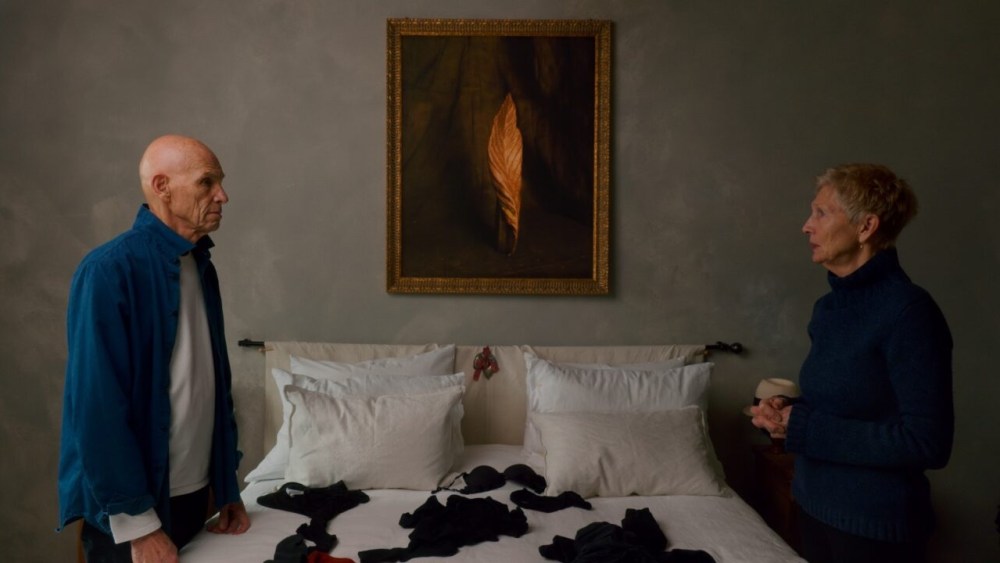‘Two Strangers Trying Not to Kill Each Other’ Review
A successful photographer celebrated around the world. A writer who resorts to publishing her own novels. Each had a long history of relationships, familial and otherwise, before they met in middle age. Now he’s 84 and she’s 75, and they are facing mortality together. Will love save them? The premise for “Two Strangers Trying Not to Kill Each Other,” Jacob Perlmutter and Manon Ouimet’s quietly relatable documentary about the marriage of Joel Meyerowitz and Maggie Barrett, sounds like the real-life companion piece to Michael Haneke’s “Amour.” Soon enough, however, it’s revealed to be closer to Justine Triet’s “Anatomy of a Fall,” a dissection of a marriage full of resentment and hidden grievances.
Barrett and Meyerowitz met at the right time to start a lasting relationship. Both had seen strife and happiness, which led them to have a real connection. As they are presented in the film, the main driver of their differences is Meyerowitz’s successful creative life and Barrett’s frustrating one. It could be the story of many marriages, where one spouse feels like he or she is playing second fiddle. In rooting their film in the specific details of this loving but tumultuous marriage, Perlmutter and Ouimet reveal themselves to be directors adept at capturing the tiny nuances that add up to make a life.
This marriage story is told through copious narration, manipulated scenes and flashbacks of old photos telling their history together and apart. How they met is given ample time at the beginning of the film, so as to immerse the audience in why this relationship works. It has always come with fervent feelings. Barrett and Meyerowitz are filmed separately lying on their backs on the ground, surrounded by candles. As they recount the story of their meeting, their voices quiver with desire and their faces glow with affection.
The variation of the storytelling methods makes the film enticing. Anytime audiences might ask why they should care about this privileged seemingly happy couple, the directors swerve and jolt them into being interested again. Consider such visual flourishes as capturing them with their backs to each other as they talk about their separate careers to unseen people. It’s a clearly manipulated moment that shows the differences between their professional lives, while framing the conflict at the heart of this narrative.
Despite such novel devices, much of “Two Strangers Trying Not to Kill Each Other” feels mundane, playing like a chronicle of a not particularly interesting marriage. Then “the scene” arrives, giving the film its sharp focus. Barrett’s years of resentment are finally given center stage, in the film and in her couple. With frank and angry words, she eviscerates the marriage. What sets her off is a small, banal incident — the way so many of these eruptions happen. Years of pent-up emotions gush out of her. For most of the confrontation, only Barrett appears in the frame, with Meyerowitz obscured. She’s finally seizing the spotlight, fighting to make this about her for once — another visually manipulated scene that shows the strength of the filmmaking and reveals the thesis of the film.
About half an hour into the film, after the historical setup, the doc chronicles an accident in which Barrett breaks her leg. That becomes the focus of “Two Strangers Trying Not to Kill Each Other” for a while. How Meyerowitz continues his creative life while she’s confined to recuperating, only trying to survive, becomes another point of friction. They negotiate how he should take care of her. She’s demanding and mercurial; he’s perplexed, well-meaning but unable to make decisions. This accident might have been seen by the filmmakers as the catalyst of this narrative. But before long, Barrett is back on her feet, the story of the marriage continues with the accident seemingly forgotten. By making Barrett’s ailment a focal point and giving it specific importance, the filmmakers end making their film disjointed. It’s just one of many incidents that adds to the cumulative effect.
Barrett and Meyerowitz open up their relationship honestly, inviting curious eyes without any vanity on their part. Perlmutter and Ouimet’s observational filmmaking is attuned to capturing the nuances that make this story intriguing, even if they do not always know where to focus. As a story of mortality, “Two Strangers Trying Not to Kill Each Other” doesn’t quite succeed. But as a story of a marriage of creative people maintaining their connection despite many frustrations, it reveals a specific narrative that many people will relate to.

